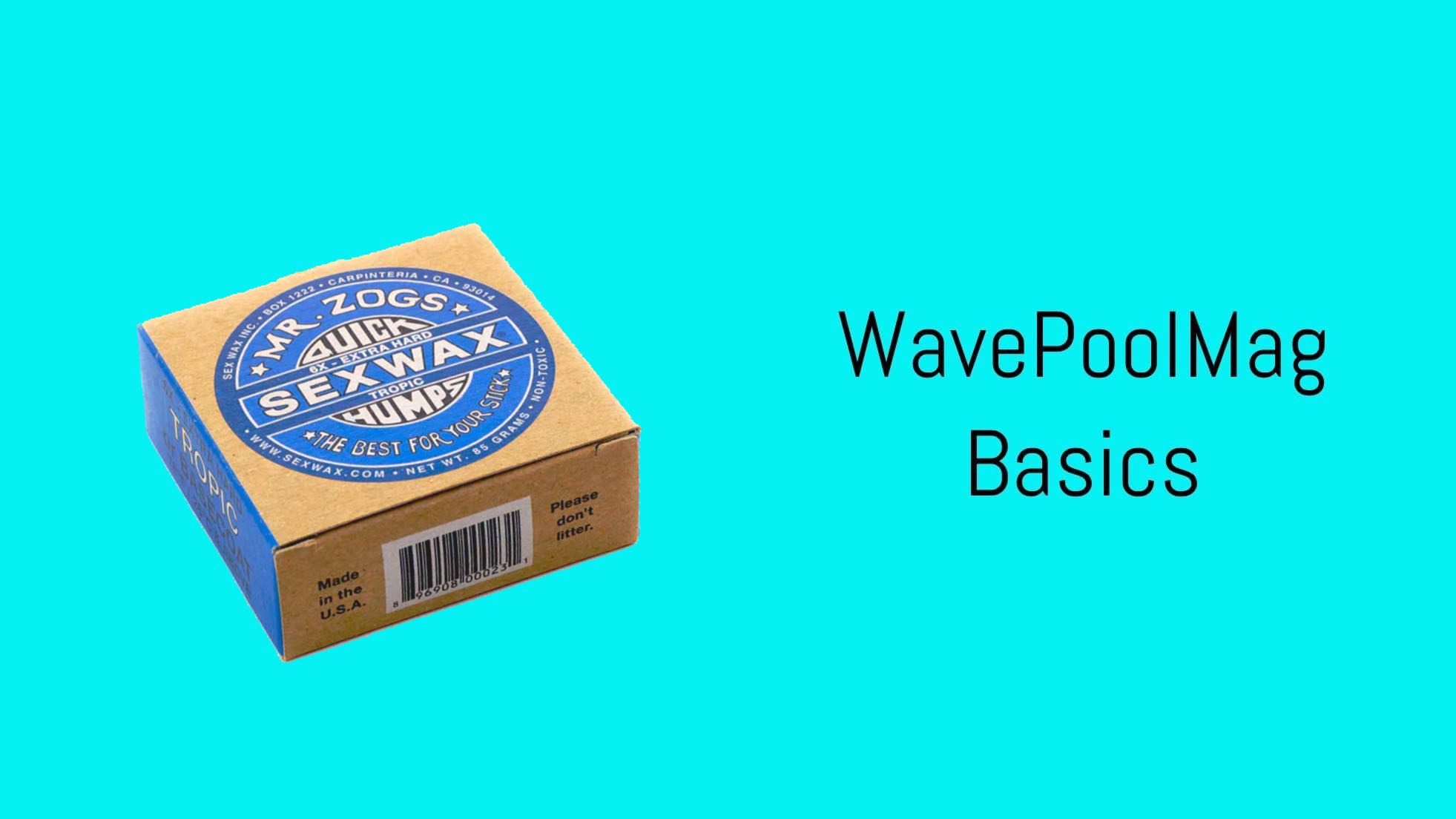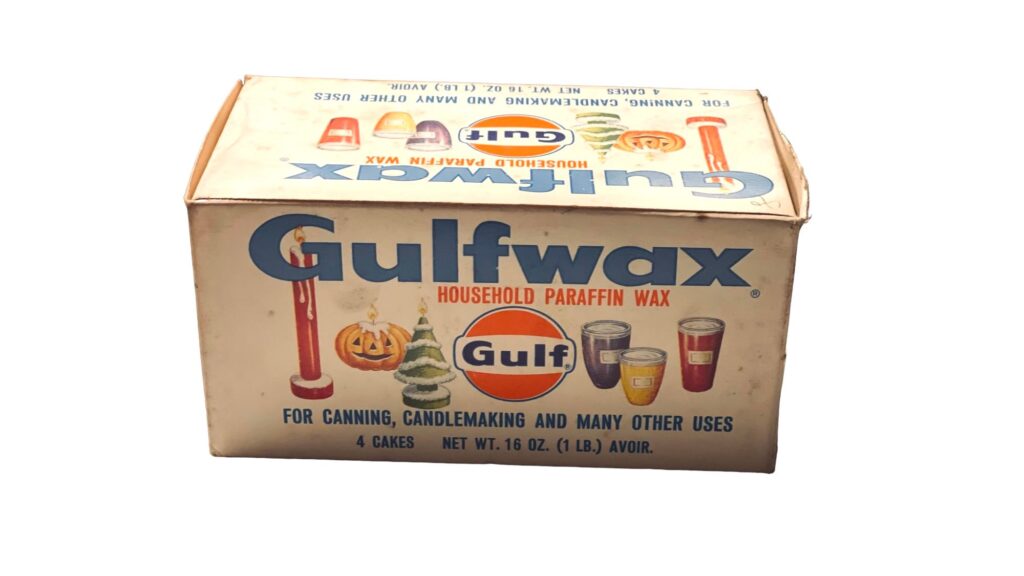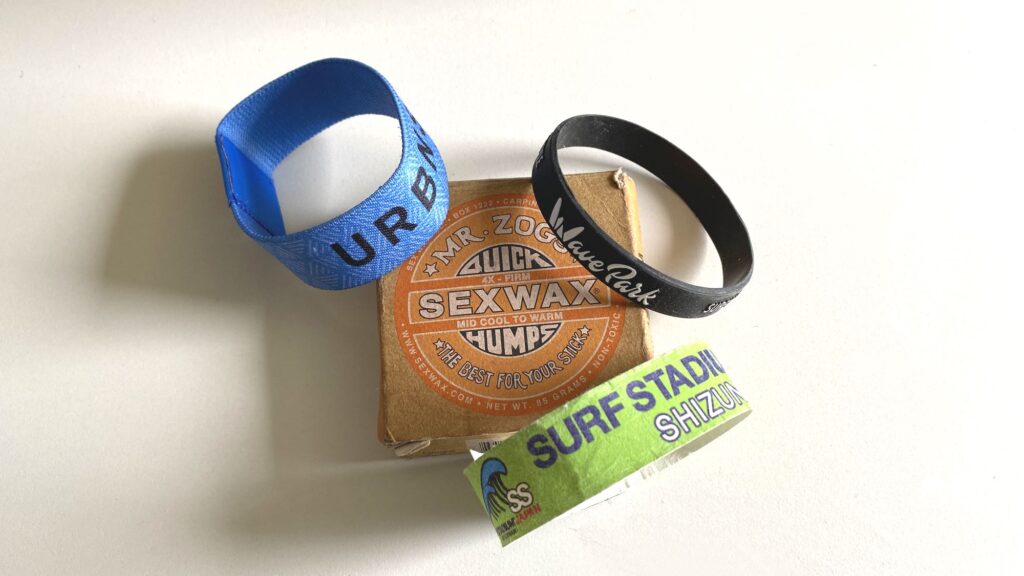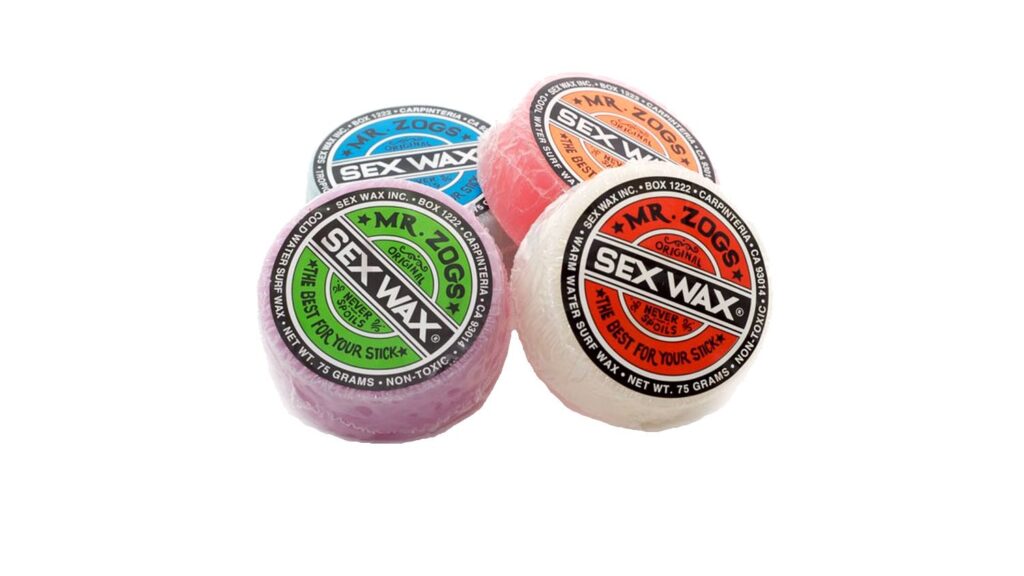Decode the mysteries of surf wax

WavePoolMag Basics is an ongoing series providing essential surf gear information to those new to the wave pool, and surfing. This article covers surfboard wax, its history, types of wax and application. From temperatures, brands, scents and base coats to waxing a foamy – everything you need to know about surf wax.
Surf wax is almost as crucial to surfing as the surfboard itself. It’s the only thing keeping your toes stuck to the board whether you are standing up on your first wave or flying out of a tube.
But with so many types of wax, selecting the right one can be a daunting task. Between competing brands, scents, textures, formulas, and softness, selecting a bar of wax takes a bit more thought than it did decades ago when the technology was in its infancy.
This article will decode the mysteries of surf wax and help you become an expert, especially for those of you who are new to surfing in a wave pool.

History
As the story goes, back in 1935 a young Californian surfer named Alfred “Al” Gallant Jr. was fed up with the textured finishes on surfboards at the time, a skin-scraping mixture of sand and varnish. When he got home one day and felt the sticky feel of the paraffin wax his mother had used on their home floors, a lightbulb went off in his head.
Perhaps, the same could be used on a surfboard.
Gallant Jr. described his discovery in a letter that he wrote to Longboard Magazine in 1999:
“One night I came home from the Cove and walked across the living room floor and my feet would almost stick on the wooden floors. My mother had waxed the floors with liquid wax. When I left to go to the Cove the next morning, I took the bottle of wax and put it on my board. When surfing, my feet just almost stuck on the board. It worked fine.”
“However, when I got home that night my mother was screaming at me. She said, “Where’s the floor wax?” I told her we put it on the surfboards so our feet wouldn’t slip. Then mom said, “Use the stuff we use on the top of the jam jars.”
“The next day I took the paraffin wax and put it on my boards and all the other guys’ boards. That’s how it started.”
After Gallant Jr’s big discovery, it still took nearly three decades for a commercial wax to hit the market. In 1963 a product called “Surf Wax” was created by the California company “Surf Research”.
In the ‘70s the surf wax market started to take off with the emergence of the classic wax brands that still dominate the market today like Sticky Bumps, Sex Wax, and Fu Wax.
In the ‘80s and ‘90s, the top brands were producing more than a million bars of wax each year. Eventually, formulas began to address specific temperature needs with cold water, tropical and everywhere-in-between formulas coming to market.
Wax formulas also became more complicated and were treated as highly confidential trade secrets.
What is surf wax made of?
Most surf waxes you see at your local surf shop today are made from paraffin wax, mineral wax, soy wax, or beeswax, mixed with other chemicals to achieve the desired level of stickiness. The wax brands closely guard the exact formulas.
The ingredients also differ between cold and warm water wax. Cold water wax uses more natural oils and sticky agents to maintain its qualities with cold water.
For example, a box of Sticky Bumps lists the following ingredients: Calcite, Natural Mineral Waxes, a proprietary blend of tackifiers, and meadowfoam seed wax.
According to Sex Wax’s website, they use paraffin wax as the base and claim it is the best available wax to achieve the qualities necessary for surfing.
However, conventional methods for producing wax, and the wax itself, present environmental issues. Paraffin wax is derived from petroleum, coal, or oil shale. And even many of the alternatives to paraffin, like soy wax, involve non-renewable petrochemical resources through the production process.
Many brands have been searching for eco-friendly ways to make surf wax, with biodegradable ingredients like coconut oil, beeswax, and essential oils. But be careful about what is marketed as eco because there is no regulation on the definition of eco wax.
And even with eco waxes, you can’t make everyone happy, so organizations like PETA call for boycotts on beeswax products.
If you are looking for a DIY approach, you can find recipes online that involve a combination of tree sap, candle wax, beeswax, and coconut oil.
What is surf wax used for?
Surf wax keeps your feet gripped snuggly on the board, but not too snuggly. You want your feet to feel firmly in place, yet still able to move around to make adjustments if necessary.
Surf wax is generally used on the deck of a surfboard, but its uses have spread throughout the spectrum of wave-riding sports. Skimboards use wax on their deck and bodyboarders often apply wax to the rails towards the nose for extra grip.
Soft surfaces, such as a soft top surfboard or bodyboard, will not pick up wax as easily as a hard surface, like a fiberglass surfboard, but even so they provide grip that is preferable to not using wax at all.

What are the different types of surf wax?
There are only a few surf frontiers left on the planet today. That means you will find surfers in most of the world, from the frigid waters of the Arctic all the way to the tropics of the Caribbean. As a result, surf wax needs to be able to adapt to all environments.
Surf waxes come suited for a range of temperatures – softer waxes for cold water and harder waxes for warm water. The waxes’ properties, designed for a specific temperature range, will make sure it remains the perfect amount of sticky for the water that you are surfing in.
If you try to use cold water wax in warm water, it will soften and slide right off the board. And if you try warm water wax in cold water, it will be hard as a rock and provide little-to-no grip.
There also is basecoat wax, which is extremely hard. Used by itself, it’s only useful in the warmest of waters. In cooler water, it works well as a first layer of wax to create bumps that serve as a foundation for a stickier, colder wax on top.
Even though all brands of wax will have a range of products for all water temperatures, not all waxes are created equal. Some formulas will be stickier, while others will be a little harder. Neither is inherently better than the other. It all comes down to preference.
For example, Fu Wax, which has long been popular in Brazil but has now been gaining traction abroad, is known for its ultra sticky properties. Your feet stick to the board quite well, but the trade off is that you might find a lot of wax stuck to your board shorts and rashguard, too.
Additionally, wax manufacturers often add a scent into their formulas to make it more appealing. The scent really has no effect on use or performance, but it’s a nice addition to increase its marketability and add a pleasant smell to an otherwise industrial-smelling material.
How do I apply surf wax?
There is no one correct way to apply wax to a surfboard, but there are some techniques that are generally accepted as beneficial to applying a nice coat of wax.
Here are some steps to follow:
1. When applying wax to a fresh deck, make sure that the board is free of debris like dust or sand.
2. Pick the correct wax for your water temperature. If you are surfing mild to cold water, feel free to start with a basecoast. A basecoast is not necessary, but it will create firmer wax bumps that will, in theory, hold form longer than if you hadn’t used basecoat.
3. When first putting the wax on the board, some people like to create striped patterns with lines of wax.
4. Start applying the wax gently in light, small circular motions. Apply enough pressure that the wax sticks to the board, but not too much pressure that it smears. Patience is key for a good wax job.
5. Apply until the desired level of bumps is achieved. Note: There is too much of a good thing. You don’t want to overwax your board and add unnecessary weight.
6. A fresh wax job is great, but it needs to be maintained. A wax comb is a useful tool to add texture. Also, periodically scraping some wax will balance the accumulation of wax that accrues each time you add wax before a surf session.
7. After a while, your wax job will deteriorate with lots of surfing. It’s good to treat your board well and give it a new coat every now and then. To remove wax, leave the wax in the sun and scrape it with a comb or credit card, or use a liquid wax removing agent. There are also tools like the “Pickle” that are excellent at removing stubborn traces of wax. Once the wax is all removed, rinse and repeat to give your board a fresh coat starting from step 1.
You may find that applying wax to a foam surfboard is more difficult than a hard board. The wax will not form into nice bumps on a softtop, but in general, the same principles apply. Be patient, don’t push too hard, and the wax will begin to accumulate on the soft board as well.

Wax is still king… for now
There have been attempts to replace wax as the dominant surfboard grip for years. Still, nothing has dethroned wax as the best grip for a surfboard since its first use nearly nine decades ago.
Some surfers prefer to use only traction pads and other types of adhesive grips on the board have been suggested over the years, but still nothing has been able to pry the majority of surfers away from wax. It’s grip and feel under your toes is difficult to top.
But wax, of course, does have its drawbacks. It melts if left in the sun. It hoards unwanted material like sand and hair. And it inevitably finds its way into nature bit by bit, whether while you are surfing, when you are scraping your board, or when it ends up in a landfill via your trash bin. It’s not good for the environment.
There certainly is an opportunity to create a better alternative. Surely, someday a technology will come along that will replace wax. But for now, wax is the best option out there and an integral part of being a surfer. Whether surfing in a pool, the ocean, or a river, wax is a key ingredient to help you have fun and achieve your goals on a board.
Related Coverage
